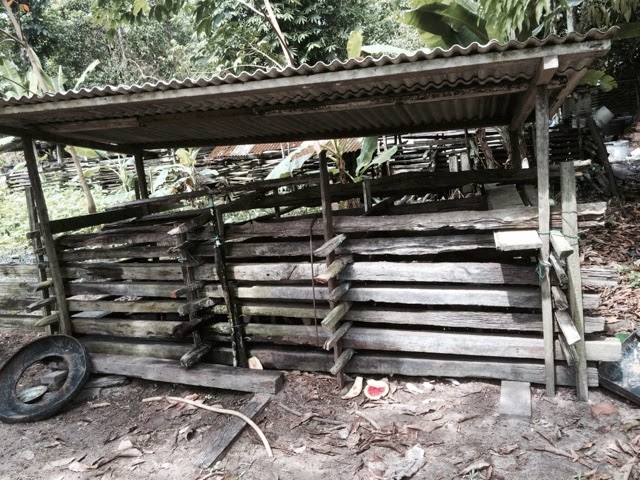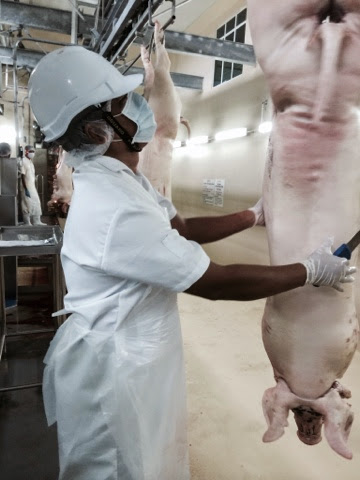Cattle integration with oil palm project owned by SALCRA, Mongkos.
Saturday, October 4, 2014
Sunday, August 10, 2014
Indigenous Pig in Lundu, Sarawak
Saturday, August 9, 2014
Wednesday, July 2, 2014
Pig blood samples taken
KEPALA BATAS: Blood samples of pigs were taken in Kampung Selamat to determine whether the latest Japanese Encephalitis case was caused by those animals in the village.
State Veterinary Department director Dr Johari Abu Bakar said 40 officers were sent to 19 pig farms located within a 1.5km radius of SK Kampung Selamat to collect blood samples.
“A total of 190 samples were taken and sent to the department’s laboratory in Bukit Tengah and Ipoh. The results are expected to be known on Friday.
“For the time being, our department will closely monitor the Kampung Selamat pig farms, which have more than 10,000 such animals,” he said when contacted yesterday.
Year Six pupil Muhammad Ammar Muqrish Zulkifli from SK Kampung Selamat in Tasek Gelugor, Butterworth, was believed to have contracted JE while on a camp programme organised by the school at its premises in April.
Pig farmer Teoh Chiew Seong, 72, said there should be no finger-pointing before the blood test results are out so that any public anxiety can be avoided.
“No one can confirm whether the disease originated from the pigs here (Kampung Selamat). Pigs are not the only animals which carry the JE virus. It can also be from birds or even cows or goats (through its vector, the Culex mosquito).
“However, pig farmers here are willing to cooperate with the authorities by allowing them to collect blood samples from the pigs for test,” he said, adding that there were about 700 families staying in Kampung Selamat, of which 80 were involved in pig farming activities.
Doctors said Muhammad Ammar was out of danger but the disease had damaged his brain.
Consultant neurologist Dr Wong Yee Choo said that the boy suffered permanent oral disability, was unable to talk or walk and in a semi-conscious state.
“His fever is under control but the infection has damaged his brain and he suffers from occasional seizures.
“He will have to undergo rehabilitation. Even then, he may never fully recover,” he said when met at Pantai Hospital in Bayan Baru.
Muhammad Ammar’s mother Haniza Ayob, 40, who is a factory worker, said she had accepted that her son would need constant care.
“My eldest child can open his eyes and move his hands but he is unable to say anything to us.
“My husband works as a factory supervisor. We are at our wit’s end as we have already spent RM87,000 for his treatment.
“I do not know how we are going to come up with more money,” she said at the hospital.
They have four other children.
State Health Committee chairman Dr Afif Bahardin said the state government would see what it could do to provide financial help to the family.
On the pig farms being the possible cause of JE, he said he would work with the local council and state health department to conduct tests before deciding on the next course of action.The Star
Wednesday, June 11, 2014
S’pore keen to import pork from Simunjan
KUCHING: Singapore is keen to import pork from the centralised pig farming area in Pasir Puteh, Simunjan.
Natural Resources and Environment Board (NREB) controller Peter Sawal said an official delegation from Singapore inspected the centralised farm in February, conducting assessment and auditing for certification purposes.
“Singapore is keen to make the centralised farming area in Simunjan as its main producer and supplier of pork.
“The interest from Singapore is a great encouragement for the local farmers to breed pigs and produce pork there, not just for local consumption but also for the international market,” he told The Borneo Post.
Peter said Singapore is keen to import pork from the region as it is free Foot amd Mouth Disease (FMD)
He said piglets for rearing would also be produced at the centralised farm, adding that the brood stock was imported from Europe. Peter said the 2,000-acre farm, which is about 120km from here, costs RM163 million and is currently the biggest such facility in Sarawak.
It is equipped with a biogas waste treatment plant, which if fully operational would be able to produce between three and five megawatts of methane-powered electricity. The whole farming area could accommodate a standing pig population of 250,000.
“Pigs are high waste producers. One pig produces about five times more excrement than a human being does. So the biogas may be sufficient for internal use,” he said. The establishment of the centralised pig farming area is for the purpose of relocating existing pig farms in Kuching and Samarahan divisions for better control of environmental pollution associated with the industry.
It is a fully integrated complex covering the entire value-chain and is designed for zero waste discharge aside from eliminating unpleasant smells.
The facilities and management systems are designed to comply with national and international standards with modern pig farms, feed mills, abattoir and meat processing plants.
Read more: http://www.theborneopost.com/2014/04/16/local-news-coming-soon-booking-minits-16-april-12/#ixzz34K1Av7xE
































